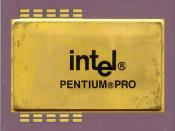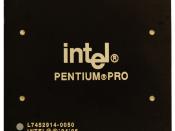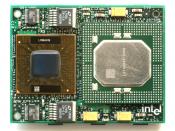Introduction
One of the Pentiumî Pro processor's primary goals was to significantly exceed the performance
of the 100MHz Pentiumî processor while being manufactured on the same semiconductor process. Using the same process as a volume production processor practically assured that the Pentium Pro processor would be manufacturable, but it meant that Intel had to focus on an improved microarchitecture for ALL of the performance gains. This guided tour describes how multiple architectural techniques - some proven in mainframe computers, some proposed in academia and some we innovated ourselves - were carefully interwoven, modified, enhanced, tuned and implemented to produce the Pentium Pro microprocessor. This unique combination of architectural features, which Intel describes as Dynamic Execution, enabled the first Pentium Pro processor silicon to exceed the original performance goal.
Building from an already high platform
The Pentium processor set an impressive performance standard with its pipelined,
superscalar microarchitecture. The Pentium processor's pipelined implementation uses five
stages to extract high throughput from the silicon - the Pentium Pro processor moves to a
decoupled, 12-stage, superpipelined implementation, trading less work per pipestage for
more stages.
The Pentium Pro processor reduced its pipestage time by 33 percent, compared
with a Pentium processor, which means the Pentium Pro processor can have a 33% higher clock
speed than a Pentium processor and still be equally easy to produce from a semiconductor
manufacturing process (i.e., transistor speed) perspective.
The Pentium processor's superscalar microarchitecture, with its ability to execute two
instructions per clock, would be difficult to exceed without a new approach.
The new approach used by the Pentium Pro processor removes the constraint of linear
instruction sequencing between the traditional 'fetch' and 'execute' phases, and opens up
a wide instruction window using an instruction pool. This approach allows the 'execute'
phase of the Pentium Pro processor to...


